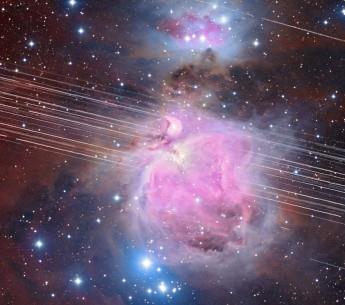
NavList:
A Community Devoted to the Preservation and Practice of Celestial Navigation and Other Methods of Traditional Wayfinding
From: Frank Reed
Date: 2021 Jun 1, 15:40 -0700
Note: this is marginally off-topic for NavList, but we have discussed satellite observing for navigation purposes before. And it's quiet... so why not?
Many of you visit the NASA Astronomy Photo of the Day or APOD website or follow related social media functions. It's one of the oldest web services on the internet. Today's image shows some satellite trails passing in front of the Orion Nebula. See it here: https://apod.nasa.gov/apod/ap210601.html (small screen cap below). This service is run by a NASA p.r. team and they frequently get minor details wrong, but I count this one as a significant failure. Here's the caption from the website, still present with the incorrect wording a few minutes ago:
Explanation: What are those streaks across Orion? Most are reflections of sunlight from numerous Earth-orbiting Starlink satellites. Appearing by eye as a series of successive points floating across a twilight sky, the increasing number of SpaceX Starlink communication satellites are causing concern among many astronomers. On the positive side, Starlink and similar constellations make the post-sunset sky more dynamic, satellite-based global communications faster, and help provide digital services to currently underserved rural areas. On the negative side, though, these low Earth-orbit satellites make some deep astronomical imaging programs more difficult, in particular observing programs that need images taken just after sunset and just before dawn. Planned future satellite arrays that function in higher orbits may impact investigations of the deep universe planned for large ground-based telescopes at any time during the night. The featured picture, taken in 2019 December, is a digital combination of over 65 3-minutes exposures, with some images taken to highlight the background Orion Nebula, while others to feature the passing satellites.
And here's another version of the explanation from the APOD Facebook page. How many differences can you find?
Explanation: What are those streaks across Orion? They are reflections of sunlight from numerous Earth-orbiting satellites. Appearing by eye as a series of successive points floating across a twilight sky, the increasing number of communications satellites, including SpaceX Starlink satellites, are causing concern among many astronomers. On the positive side, Starlink and similar constellations make the post-sunset sky more dynamic, satellite-based global communications faster, and help provide digital services to currently underserved rural areas. On the negative side, though, these low Earth-orbit satellites make some deep astronomical imaging programs more difficult, in particular observing programs that need images taken just after sunset and just before dawn. Planned future satellite arrays that function in higher orbits may impact investigations of the deep universe planned for large ground-based telescopes at any time during the night. The streaks across Orion are not from Starlink but rather satellites in high geosynchronous orbit. The featured picture, taken in 2019 December, is a digital combination of over 65 3-minutes exposures, with some images taken to highlight the background Orion Nebula, while others to feature the passing satellites.
This photo could have been taken decades ago. Observing geosynchronous satellites as they flare in front of the Orion Nebula during the twice-yearly seasons when they line up with the Sun has been part of the "fun" of the hobby of satellite watching for many years. The big difference today compared to even five or ten years ago is that astrophotography is now radically easier and cheaper. Incidentally, the creator of the photo, Iranian amateur astronomer Amir H. Abolfath, produced this image intentionally by combining the images to enhance the view of the satellites. It is also easy to eliminate satellites from photos completely with modern image-stacking techniques.
Frank Reed







